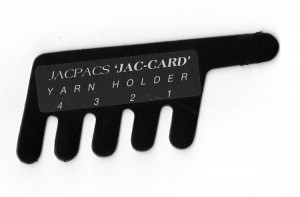Recently there has been a lot of press about a particular personality using 2 carriages in her knitting. This is not a new idea. Some points to ponder: if color changing is required there many ways to deal with it, beginning with doing it manually and devising a yarn holder of sorts to slip into space where the needle retainer bar sits. Then there are color changers, an absolute necessity in double bed work for DBJ. Not all machine models have changers that will work on both beds, Brother happens to be one that does not. Though Passap Autocolor will change colors automatically, the Brother single bed one is operated by one’s fingers pushing buttons, is a bit fussy, and it is really good not to hit an empty holder and go across with “no yarn”, since the object is usually not to have knitting fall off and onto floor.
Extra KH carriages are a bigger expense than color changers. Many production knitters have backups for their machine models. It is obviously best if both carriages are the same model year. Sometimes sequential model ones may be used, and all that may be required is a sinker plate adjustment, other times the carriages are incompatible with the new knitting beds though changes may appear to be small ones to the eye.
Unless I specify otherwise, my comments usually pertain to Brother KMs.
Aside from the fact that punchcard models have no power source, the pattern rotation is also different and that needs to be taken into consideration when punching holes in the card. Electronic machines advance a design row for each carriage pass on each side. Punchcard models do not.
In knitting stripes, the second carriage may house a thinner or thicker yarn, same yarn at a different tension, or hold the alternate color for frequent color changes. It may also be used with different cam settings than the other ie one for fair isle, the other for weaving or tuck, etc.
If combining stitch types a clear understanding of how punchcard holes and mylar or computer interface “squares” relate to needle selection and fabric formation is helpful and boils down to planning selection for needles one actually wants knitting. Patterning sequences must happen so each carriage makes an even number of passes, and returns home to its “side” for “automatic” use. Lace extension rails must be used and the alternate carriage is off the needle bed to avoid belt breakage.
The image below is a lo-tech “color changer” marketed decades ago. Old credit cards can be used for a DIY version.
